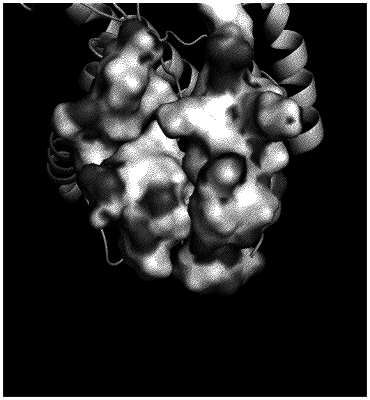| CPC G16C 10/00 (2019.02) [G16B 15/30 (2019.02)] | 4 Claims |

|
1. A method of constructing a ligand-receptor protein complex for determining different polybrominated diphenyl ethers derivatives in terms of binding activity thereof to enoyl-ACP reductase, said method comprising:
providing a ligand and a modified enoyl-ACP reductase comprising: removing the B chain of the enoyl-ACP reductase and nicotinamide adenine dinucleotide bound to the B chain; removing all water molecules attached to the enoyl-ACP reductase to obtain the modified enoyl-ACP reductase with nicotinamide adenine dinucleotide only bound to the A chain thereof; adding hydrogen atoms to the nicotinamide adenine dinucleotide of the A chain and a positive substance, wherein the positive substance is Triclosan; computationally constructing a structure of the ligand; computationally optimizing the structure of the ligand;
computationally docking the ligand to the modified enoyl-ACP reductase; computationally generating at least one binding pocket of the modified enoyl-ACP reductase; generating 20 conformations of the ligand-receptor complex after the ligand docks to the modified enoyl-ACP reductase; scoring the conformations to obtain the highest score conformation, wherein the highest score conformation is identified as a potential bioactive conformation for one or more subsequent molecular dynamic simulations;
performing at least one molecular dynamic simulation comprising: computationally optimizing the structure of the ligand including using Powell method to optimize, giving Gasteiger-Hückel charge as nuclear charges, using a molecular force field, saving optimized ligand structure in a database; undergoing 5000 steps of energy minimization before performing the molecular dynamic simulation; equilibrating energies of the complex by NVT ensemble and NPT ensemble including simulating as 500 ps in the NVT ensemble; heating gradually from 0 to 300 K under a minimum energy; further equilibrating the energies under 500 ps at 300 K in the NPT ensemble; carrying out the molecular dynamic simulation and analysing hydrogen bond, π-π stacking and halogen bond interaction under 20 ns; recording a trajectory of the simulation every 2 ps;
wherein said analysing the hydrogen bond, π-π stacking and halogen bond interaction includes determining whether the ligand forms hydrogen bond or π-π stacking to the nicotinamide adenine dinucleotide or a residue ALA196 of the modified enoyl-ACP reductase, and wherein if the ligand does not form hydrogen bond or π-π stacking to the nicotinamide adenine dinucleotide or the residue ALA196 of the modified enoyl-ACP reductase, analyzing the conformational change to determining whether a PRO154-ASN157 helix-loop region, a PHE251-ASN257 loop-helix region and a THR206-MET216 helix are adjacent to each other so as to close the binding pocket of the modified enoyl-ACP reductase;
wherein the generating at least one binding pocket of the modified enoyl-ACP reductase further comprises providing Triclosan as a positive substance so as to obtain a simulated binding pocket of the modified enoyl-ACP reductase bound to the Triclosan, wherein the modified enoyl-ACP reductase forms a receptor binding pocket around the binding site to the Triclosan; wherein a root mean square deviation is determined between the conformations of the simulated binding pocket of the modified enoyl-ACP reductase bound to the Triclosan and actual conformations of the binding pocket of an enoyl-ACP reductase;
wherein the performing at least one molecular dynamic simulation further comprises applying a generalized force field to the ligand and the nicotinamide adenine dinucleotide of the modified enoyl-ACP reductase including: optimizing the structure of the ligand and the nicotinamide adenine dinucleotide of the modified enoyl-ACP reductase;
computationally calculating an electrostatic potential thereof, fitting restrained electrostatic potential charge, generating restrained electrostatic potential file;
generating a molecular topology file;
generating a protein topology file as a force field; and
filling TIP3P water molecule in at least 2 nm away from the surface of the ligand-receptor protein complex to construct a box.
|